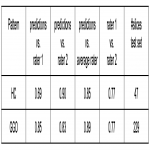Purpose
Honeycombing (HC) and ground glass opacity (GGO) patterns in lung CT are important prognostic markers in fibrotic lung diseases. Quantitative assessment is difficult due to their appearance variability and the effort of volumetric delineation. This study evaluated a machine learning model for the automatic volumetry of these patterns for quantitative assessment of interstitial lung disease.
Methods and materials
The data annotations for the HC and GGO patterns were carried out by trained annotators on slices from a diverse set of scans that contained the patterns, acquired with different scanners and patient demographics. The annotation process ensured a high quality level through an iterative quality control process. The annotations were reviewed by expert radiologists and re-annotations were carried out until the results were satisfactory. This resulted in 3949 slices that were split into 3074 slices for the training dataset and 875 for the validation...
Results
Examples of the ground truth annotations compared to the model segmentations are visualized in Figure 2. The model predictions differ mostly in the boundary regions.
[Fig 2]
The volume was calculated from the annotations of the two raters and from the model predictions. For both patterns, we report the correlation between the model predictions and the two raters. On the 47 test slices with HC, the volume inter-rater correlation was 0.77, and correlation of the model and the two raters was 0.69 and 0.90, respectively....
Conclusion
For HC and GGO, the agreement between the volume measurements of the developed model and the quality controlled annotations of the two raters is comparable to the inter-rater agreement.
The agreement of the model predictions with the average of the raters is higher than the inter-rater comparison. Furthermore, the agreement is higher between the model and each independent rater in all the cases apart from HC and one rater.
Personal information and conflict of interest
M. M. Pieler:
Nothing to disclose
J. Hofmanninger:
Nothing to disclose
R. Donner:
Nothing to disclose
A. Sikka:
Nothing to disclose
E. Jiménez Arroyo:
Nothing to disclose
H. Prosch:
Nothing to disclose
R. Zhang:
Nothing to disclose
G. Langs:
Founder: Co-Founder and Shareholder of contextflow GmbH
A. Makropoulos:
Nothing to disclose
References
[1] Siddique, Nahian, et al. "U-Net and its variants for medical image segmentation: theory and applications." arXiv preprint arXiv:2011.01118 (2020).
[2] Sorensen, Th A. "A method of establishing groups of equal amplitude in plant sociology based on similarity of species content and its application to analyses of the vegetation on Danish commons." Biol. Skar. 5 (1948): 1-34.





